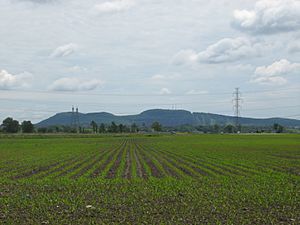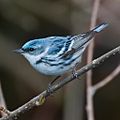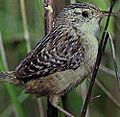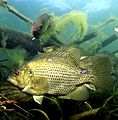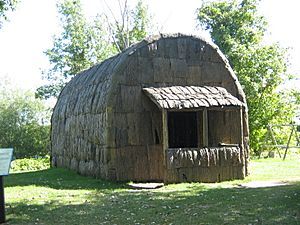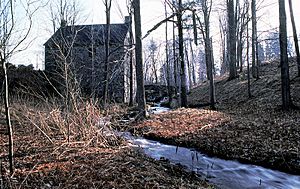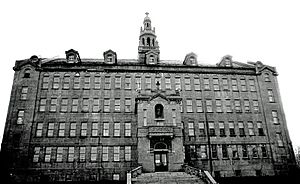Mont-Saint-Bruno National Park facts for kids
Quick facts for kids Mont-Saint-Bruno National Park |
|
|---|---|
|
IUCN Category II (National Park)
|
|
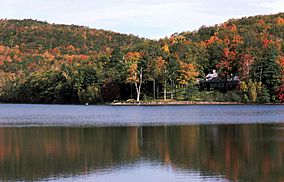
Seigneurial Lake
|
|
| Location | Saint-Bruno-de-Montarville, Quebec, Canada |
| Nearest city | Montreal |
| Area | 8.84 km2 (3.41 sq mi) |
| Established | 1985 |
| Visitors | 750,000 |
| Governing body | Société des établissements de plein air du Québec |
Mont-Saint-Bruno National Park (French: Parc National du Mont-Saint-Bruno) is a cool national park in Quebec, Canada. It's located about 15 kilometres (9.3 mi) east of Montreal, near the town of Saint-Bruno-de-Montarville. The park covers an area of 8.84 square kilometres (3.41 sq mi) (about 3.4 square miles).
The park is home to Mont Saint-Bruno, a mountain that is part of the Monteregian Hills. This mountain reaches 218 metres (715 ft) (about 715 feet) high. Even though it's not huge, the mountain is famous for its many different plants and animals. Long ago, the lakes on the mountain helped power water mills, which were important for the local economy. You can still see one of these old mills, called the "Vieux Moulin" (Old Mill), which is now a cozy spot for visitors.
In the early 1900s, the mountain became a popular place for vacation homes and for religious groups to grow food. One group, the Brothers of Christian Instruction of St Gabriel, even built a school and a special garden for trees called an arboretum. In 1976, the Government of Quebec bought part of the mountain to protect it. The park officially opened in 1985 and has been managed by SÉPAQ (Société des établissements de plein air du Québec) since 1999.
About 750,000 people visit the park every year. Popular activities include hiking, cross-country skiing, and alpine skiing.
Contents
What's in a Name?
The park gets its name from Mont Saint-Bruno, the mountain it protects. The mountain itself was named after the nearby town of Saint-Bruno-de-Montarville. In the past, people called it the "Montarville hill," after the old area it was in. The name changed to Saint-Bruno when a church parish was created there. The parish was named to honor the Bruneau family, who helped fund it.
Park Geography
The park covers 8.84 square kilometres (3.41 sq mi) and includes part of Mont Saint-Bruno, which is one of the nine Monteregian Hills. The mountain is 218 metres (715 ft) tall. It's located about 18 kilometres (11 mi) east of Montreal and is surrounded by the towns of Saint-Bruno-de-Montarville, Sainte-Julie, and Saint-Basile-le-Grand.
How the Mountain Formed
Mont Saint-Bruno was formed in a similar way to the other Monteregian Hills. About 124 million years ago, hot, melted rock (magma) pushed up into the Earth's crust. Over a very long time, the softer rock layers on top wore away, leaving behind the harder core of the mountain. This is why the Monteregian Hills are not volcanoes, even though they look a bit like them.
The mountain's round shape today is thanks to the last ice age. Huge glaciers moved across the land, smoothing out the mountain. Later, part of the mountain was covered by the Champlain Sea, which left behind layers of clay, sand, and gravel.
The mountain is mostly made of hard rocks like peridotite, gabbro, and syenite. These are surrounded by older shale and siltstone rocks that changed when the hot magma pushed through.
Mountain Shape
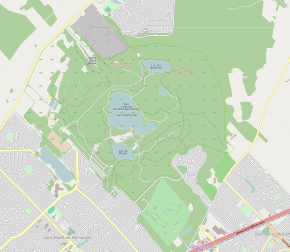
Mont Saint-Bruno is like an "island mountain" that rises 218 metres (715 ft) above the flat land around it, which is usually about 30 metres (98 ft) high. The highest parts of the mountain are on its northeast side, forming a circle around a lake called "lac des Bouleaux" (Birch Lake). The land slopes down gradually towards the southeast, with some dips that are filled with water.
Lakes and Streams
Even though the park is small, it has a good network of water bodies. There are five lakes, one bog (a type of wetland), two man-made ponds, and many streams. All this water flows into the Richelieu River. Three of the lakes – du Moulin, Seigneurial, and des Bouleaux – are used to supply drinking water to Saint-Bruno-de-Montarville.
Park Climate
The climate in this part of Quebec is mild, with moderate humidity. It's one of the warmest areas in the province. The average temperature in the park is 6 °C (43 °F) (about 43°F). Temperatures stay above 0 °C (32 °F) (32°F) for about 149 days a year. The park gets about 1,014 millimetres (39.9 in) (40 inches) of rain and snow each year, with about 239 centimetres (94 in) (94 inches) of that being snowfall.
Even though the mountain is only 218 metres (715 ft) high, the weather at the top can be a bit harsher than at the bottom. This causes different types of trees to grow at different heights. For example, you'll find sugar maple and bitternut hickory at the base, but more northern red oak and sugar maple near the summit.
| Climate data for Montréal (McGill) | |||||||||||||
|---|---|---|---|---|---|---|---|---|---|---|---|---|---|
| Month | Jan | Feb | Mar | Apr | May | Jun | Jul | Aug | Sep | Oct | Nov | Dec | Year |
| Record high °C (°F) | 12.8 (55.0) |
15.0 (59.0) |
25.0 (77.0) |
30.0 (86.0) |
32.8 (91.0) |
34.8 (94.6) |
36.1 (97.0) |
35.6 (96.1) |
32.8 (91.0) |
28.9 (84.0) |
22.2 (72.0) |
15.0 (59.0) |
36.1 (97.0) |
| Mean daily maximum °C (°F) | −5.4 (22.3) |
−3.7 (25.3) |
2.4 (36.3) |
11.0 (51.8) |
19.0 (66.2) |
23.7 (74.7) |
26.6 (79.9) |
24.8 (76.6) |
19.4 (66.9) |
12.3 (54.1) |
5.1 (41.2) |
−2.3 (27.9) |
11.1 (51.9) |
| Mean daily minimum °C (°F) | −12.4 (9.7) |
−10.6 (12.9) |
−4.8 (23.4) |
2.9 (37.2) |
10.0 (50.0) |
14.9 (58.8) |
17.9 (64.2) |
16.7 (62.1) |
11.9 (53.4) |
5.9 (42.6) |
−0.2 (31.6) |
−8.9 (16.0) |
3.6 (38.5) |
| Record low °C (°F) | −33.5 (−28.3) |
−33.3 (−27.9) |
−28.9 (−20.0) |
−17.8 (0.0) |
−5.0 (23.0) |
1.1 (34.0) |
7.8 (46.0) |
6.1 (43.0) |
0.0 (32.0) |
−7.2 (19.0) |
−27.8 (−18.0) |
−33.9 (−29.0) |
−33.9 (−29.0) |
| Average precipitation mm (inches) | 73.6 (2.90) |
70.9 (2.79) |
80.2 (3.16) |
76.9 (3.03) |
86.5 (3.41) |
87.5 (3.44) |
106.2 (4.18) |
100.6 (3.96) |
100.8 (3.97) |
84.3 (3.32) |
93.6 (3.69) |
101.5 (4.00) |
1,062.6 (41.85) |
| Average snowfall cm (inches) | 45.9 (18.1) |
46.6 (18.3) |
36.8 (14.5) |
11.8 (4.6) |
0.4 (0.2) |
0 (0) |
0 (0) |
0 (0) |
0 (0) |
2.2 (0.9) |
24.9 (9.8) |
57.8 (22.8) |
226.4 (89.2) |
| Average precipitation days (≥ 0.2) | 15.8 | 12.8 | 13.6 | 12.5 | 12.9 | 13.8 | 12.3 | 13.4 | 12.7 | 13.1 | 15.0 | 16.2 | 164.1 |
| Source: Environment Canada | |||||||||||||
Plants and Animals
Mont-Saint-Bruno National Park is part of the Saint Lawrence Lowlands ecoregion. This area has the warmest climate in Quebec. It's known for its mixed forests with trees like sugar maple, yellow birch, Canadian hemlock, and eastern white pine. A lot of this region is used for farming, and it's also home to big cities like Montreal and Ottawa.
Park Plants
The park is home to 574 different kinds of plants! That's about 20% of all the plant species found in Quebec.
- Below 140 metres (460 ft) (about 460 feet), the forest has a lot of maple and bitternut hickory (Carya cordiformis).
- Between 100 metres (330 ft) and 140 metres (460 ft), you'll mostly see sugar maple (Acer saccharum), along with American tilia (Tilia americana) or red oak (Quercus rubra).
- Other trees and plants in the park include Canadian hemlock (Tsuga canadensis), American hophornbeam (Ostrya virginiana), yellow birch (Betula alleghaniensis), moosewood (Viburnum lantanoides), and northern whitecedar (Thuja occidentalis).
Sadly, 24 plant species in the park are considered threatened species. Some of these include:
- Northern maidenhair fern (Adiantum pedatum)
- Wild garlic (Allium tricoccum)
- American ginseng (Panax quinquefolius)
- White trillium (Trillium grandiflorum)
- Various types of sedge plants
Park Animals
Mammals
You can find 38 different kinds of mammals in Mont-Saint-Bruno National Park. The largest mammal here is the white-tailed deer (Odocoileus virginianus). Some of the most common small mammals are the eastern grey squirrel (Peromyscus leucopus), the white-footed mouse (Peromyscus leucopus), the eastern chipmunk (Tamias striatus), and the groundhog (Marmota monax).
Three types of bats that live in the park are considered threatened: the silver-haired bat (Lasionycteris noctivagans), the hoary bat (Lasiurus cinereus), and the eastern red bat (Lasiurus borealis).
Birds
Mont-Saint-Bruno National Park is a birdwatcher's paradise! You can spot 234 different bird species here, which is 72% of all bird species found in Quebec. Many of these are birds of prey, like the red-shouldered hawk (Buteo lineatus), the Cooper's hawk (Accipiter cooperii), and various owls such as the eastern screech owl (Megascops asio) and the great horned owl (Bubo virginianus).
Five bird species in the park are threatened: the peregrine falcon (Falco peregrinus), the sedge wren (Cistothorus platensis), the Cerulean warbler (Setophaga cerulea), the chimney swift (Chaetura pelagica), and the common nighthawk (Chordeiles minor).
Reptiles and Amphibians
The park is home to seven species of reptiles, including the common snapping turtle (Chelydra serpentina), the painted turtle (Chrysemys picta), and the common garter snake (Thamnophis sirtalis).
You can also find 14 species of amphibians here, like the eastern newt (Notophthalmus viridescens), the spotted salamander (Ambystoma maculatum), the American toad (Anaxyrus americanus), and the bullfrog (Lithobates catesbeiana). Four of these species are threatened: the four-toed salamander, the pickerel frog, the northern map turtle, and the ringneck snake.
Fishes
There are 13 different kinds of fish living in the park's lakes. Some common ones include the pumpkinseed (Lepomis gibbosus), the smallmouth bass (Micropterus dolomieu), the yellow perch (Perca flavescens), and the common carp (Cyprinus carpio).
Park History
While no direct signs of ancient human settlements have been found in the park, it's believed that indigenous people lived in this area for at least 8,000 years. The St. Lawrence Iroquoians were the native people associated with this region, but they disappeared around the late 1500s.
In 1710, the land of Montarville was given to Pierre Boucher. It took about 30 years for the area to really start developing. Unlike other areas near Montreal that used wind to power their mills, Saint-Bruno used water. At one point, there were five water mills built between 1725 and 1816. These mills were used for grinding wheat, tanning leather, processing wool, and sawing wood. The only mill still standing today is the grain mill, rebuilt in 1761.
In 1897, a wealthy banker from Montreal named Edson Loy Pease bought a large part of the mountain (405 hectares (1,000 acres)). He then helped create the Mount Bruno Association to manage the land. This association built 10 vacation homes between 1899 and 1940, some of which are now inside the park.
In the early 1900s, several religious groups bought land on the mountain. They wanted to escape the growing city of Montreal and grow food for their schools. The Brothers of Christian Instruction of St Gabriel had the biggest impact. They moved to the mountain in 1912 and later bought more land, including a large villa. They found success with apple orchards and dairy farming. In 1925, they built a seminary, which became their most important school in Quebec. They eventually sold all their land to the Quebec government in 1976. Today, only the apple orchard and a small arboretum (tree garden) remain from their time there.
A quarry operated on the mountain from 1928 to the mid-1940s, leaving a large hole 115 metres (377 ft) wide, 140 metres (460 ft) long, and 40 metres (130 ft) deep. In 1965, the Ski Mont Saint-Bruno ski resort opened. Because it's so close to Montreal, it has become a very popular place for ski lessons.
How the Park Was Created
In 1969, the town of Saint-Bruno-de-Montarville bought 1.5 square kilometres (0.58 sq mi) of the mountain to protect its drinking water supply. People wanted to protect the mountain even more, so the Quebec government bought all the land in 1975 and 1976 to create a park and a fishing and hunting reserve.
Public meetings were held in 1982 to plan for a provincial park. In 2001, the park's status changed to "national park," like all other provincial parks in Quebec. In 2012 and 2013, the park's area was officially expanded to include more important natural areas, like a bog and the main hills that were previously outside its official boundaries.
Park Management
Like most other national parks in Quebec, Mont-Saint-Bruno National Park has been managed by the Société des établissements de plein air du Québec (SÉPAQ) since 1999. SÉPAQ is in charge of offering activities, providing services, and protecting and promoting the park.
In Quebec's national parks, it's against the rules to cut down trees, mine for minerals, or produce energy. Hunting, trapping, and poaching are also forbidden. This helps keep the park's nature safe.
The park shares its main office with the Îles-de-Boucherville National Park, which is about 10 kilometres (6.2 mi) to the west.
Visiting the Park
Mont-Saint-Bruno National Park welcomes about 750,000 visitors each year. This makes it the third most visited park in Quebec, after Gatineau Park and Saguenay–St. Lawrence Marine Park. You can visit the park all year round, but there are no places to stay overnight inside the park itself.
In the summer, you can explore over 30 kilometres (19 mi) of hiking trails. You can also ride bikes on the park's service roads. From August to October, the apple orchard is open, and you can pick your own apples!
In the winter, cross-country skiing and hiking are very popular activities.
Mont-Saint-Bruno National Park is one of only three national parks in Quebec that also has an alpine skiing resort. Ski Mont Saint-Bruno opened in 1965. It's a smaller ski area but is well-known for its large ski school, which has 562 teachers and teaches about 30,000 students each season. The resort has 15 ski slopes and sees about 300,000 skiers every winter.



